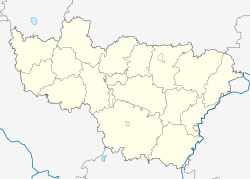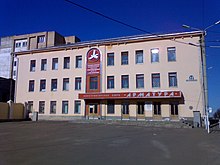Kovrov
| city
Kovrov
Ковров
|
||||||||||||||||||||||||||||||||||||||||||
|
||||||||||||||||||||||||||||||||||||||||||
|
||||||||||||||||||||||||||||||||||||||||||
| List of cities in Russia | ||||||||||||||||||||||||||||||||||||||||||
Kowrow ( Russian Ковро́в ) is a major Russian city with 145,214 inhabitants (as of October 14, 2010) and the center of the raion of the same name in the Vladimir region .
It is located on the right bank of the Klyazma River , around 250 km east of Moscow and 64 km east of the regional capital, Vladimir . The nearest town is Kameshkovo 19 km west of Kovrov. The administrative border between the Oblasts of Vladimir and Ivanovo runs around 10 km north of Kovrov .
history
Kovrov was founded in the 12th century as a village called Roshdestvenskoje . Grand Duke Andrei Bogoljubski had the wooden church of the Nativity built there, which gave the place its name (Nativity, Christmas = in Russian roschdestwo ).
In the 16th century Roshdestvenskoje belonged to the prince and statesman Vasily Andrejewitsch Starodubsky, who served as Moscow's governor in the Perm region from 1503–1506 . According to legend, he captured a luxurious oriental carpet during a battle with the Tatars , which is said to have given his family the surname and the place Roshdestwenskoje the name Kovrowo (from the Russian word kowjor = carpet).
Since the late 16th century, at the instigation of Tsar Ivan IV "the Terrible", annual fairs were held in Kovrovo , for which the location on the then navigable Klyazma and near the trade route from Moscow to Nizhny Novgorod was well suited. Trade in Kowrowo flourished in the 18th century. In 1778, as part of a regional reform under Catherine II, the Kowrowo settlement became the district town of Kovrov within the Vladimir governorate .
In the late 18th and early 19th centuries, the city was ravaged by major fires several times, and the new road laid in 1830 between Moscow and Nizhny Novgorod Kovrov bypassed it. As a result, there was a temporary economic decline Kowrov, since the annual fairs were now of no great importance. The situation only improved with the construction of the important railway line from Moscow to Nizhny Novgorod in the 1860s, which passed through Kovrov. This resulted in larger railway workshops in Kowrow, which originally also made wagons. Textile industry was also built in the city.
The city did not become more industrialized until the Soviet era : the first excavator factory in the Soviet Union was built in the 1930s on the basis of the existing workshops . The First Russian Rifle and Machine Gun Factory , founded in 1916, is still an important weapon manufacturer in Russia.
Population development
| year | Residents |
|---|---|
| 1897 | 14,571 |
| 1939 | 67.105 |
| 1959 | 98,563 |
| 1970 | 123.307 |
| 1979 | 142,860 |
| 1989 | 159,942 |
| 2002 | 155,499 |
| 2010 | 145.214 |
Note: census data
Cityscape
In addition to the more modern high-rise buildings, some of which date back to the communist era, Kovrov also has several districts with unpaved roads and old Russian wooden houses, which allow an insight into life in central Russia from the beginning of the 20th century. The enclosed gardens often feature beds and small greenhouses, in which the residents grow vegetables and fruit, as is customary in Russia. Due to the nearby river Klyazma it comes in the fall regularly be mosquitoes, the mosquitoes occur in large flocks and allow a stay in the open only with appropriate clothing.
economy
Today Kovrov is mainly a heavy industry location. In addition to the Kowrowez dredging works , the armaments factories of Kowrower Mechanisches Werk and Degtjarjowwerk , an equipment factory and the Armatura design office for space technology are among the most important companies in the city. In addition, office and sanitary containers are produced in large numbers. The company Containex is co-owner . The textile industry, which was once important, is only of minor importance.
The only university in the city is the Kovrov State Technological Academy.
traffic
There is a side road from Kovrov to the M7 trunk road , which emerged from the former trade route from Moscow to Nizhny Novgorod. Kovrov has a long-distance station on the parallel railway main line, which begins at the Kursk railway station in Moscow, the reception building of which was rebuilt in 2003. Since 1975 the inner-city public transport in Kowrov has had its own trolleybus network .
The nearest civil airport is in Ivanovo , from where there are daily flights to Moscow.
Town twinning
Kovrov lists the following three twin cities :
| city | country |
|---|---|
| Brest |
|
| Čačak |
|
| Liberec |
|
Personalities
sons and daughters of the town
- Vladimir Shuralev (* 1935), Army General
- Viktor Kalygin (1950-2004), Celtologist
- Natalja Kutjakowa (* 1986), athlete
- Irina Tarasova (* 1987), shot putter
- Alexander Foliforow (* 1992), racing cyclist
Personalities related to the city
- Sergei Simonow (1894–1986), weapons designer
- Georgi Schpagin (1897–1952), weapons designer
Individual evidence
- ↑ a b Itogi Vserossijskoj perepisi naselenija 2010 goda. Tom 1. Čislennostʹ i razmeščenie naselenija (Results of the All-Russian Census 2010. Volume 1. Number and distribution of the population). Tables 5 , pp. 12-209; 11 , pp. 312–979 (download from the website of the Federal Service for State Statistics of the Russian Federation)
- ↑ Как живут города-побратимы Коврова / Соцсети / Город Ковров.Ru. Retrieved October 30, 2016 .
- ↑ Шуралёв Владимир Михайлович , encyclopedia.mil.ru (Russian)
Web links
- Kovrov City Council (Russian)
- City unofficial website (Russian)
- Kovrov on mojgorod.ru (Russian)





